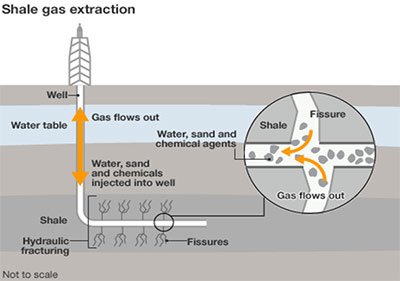Why in news?
Reliance exits shale gas business in US
Context-
As Reliance Industries Ltd (RIL) aims for a net-zero carbon emissions future by 2035, the company is exiting its conventional oil and gas businesses.
Shale gas
Shale gas is a form of natural gas (mostly methane), found underground in shale rock. It is classified as ‘unconventional’ because it is found in shale, a less permeable rock formation than sandstone, siltstone or limestone in which ‘conventional’ gas is found, and it is generally distributed over a much larger area. It does not flow easily.
How is shale gas different from conventional gas?
Hydrocarbons, such as oil and gas, are produced by the transformation of organic matter (plants; animals; algae, etc.) as a result of increased temperature and pressure. This occurs when a potential source rock, rich in organic matter, is buried and heated at considerable depth (usually thousands of metres below the surface).
The hydrocarbons migrate upwards where they may find their way into porous reservoir rocks, typically a sandstone or a porous limestone
How is shale gas extracted?
- Hydraulic fracturing – commonly known as fracking – is the process used to extract shale gas.
- Deep holes are drilled down into the shale rock, followed by horizontal drilling to access more of the gas reserves, as shale reserves are typically distributed horizontally rather than vertically.
- Fracking fluids containing sand, water and chemicals are then pumped at high pressure into the drilled holes, to open up fractures in the rock, enabling the trapped gas to flow through the fractures into collection wells.
- From there it is piped away for commercial use. Recovery rates for shale gas are much lower than for conventional gas.
Advantage –
Shale gas is a cleaner-burning than coal or oil.
Concerns –
- The drilling and fracturing of wells require large amounts of water, leading to some environmental concerns.
- Shale gas extraction could undermine climate change commitments if it replaces the use of renewables.
- Other concerns regard local community impacts through the potential noise pollution, increased road traffic (due to lorry movement), damage to the natural environment and space required for drilling sites.
Reserve
- The largest estimated resources are in China (31.6 tcm), followed by Argentina (22.7 tcm), Algeria (20 tcm), the United States (17.6 tcm) and Canada (16.2 tcm).
- ONGC has identified 50 nomination PML (Petroleum Mining Lease) blocks under Phase-I. The exploratory efforts so far have led to the discovery of 65 small-to-medium sized hydrocarbon fields with about 356 million tonnes (oil and oil equivalent gas) of initial in-place on-land reserves. The current production of oil and gas is 750-800 tonnes per day and 2.5-3 million cubic metres of gas, respectively
- Exploration for assessing the Shale gas/oil prospectivity has been initiated in 4 basins of the country viz., Cambay, KG, Cauvery and A&AA Basins.
Source- livemint







